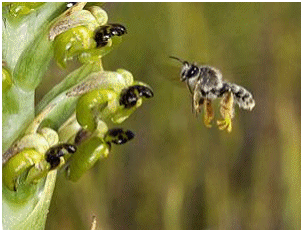NEWS
Thank bees for orchids' diversity
§ 15:10 01 February 2011 by Michael Marshall
§ For similar stories, visit the Evolution and Love and Sex Topic Guides

Orchids owe their enormous variety to the bees and other insects that pollinate them.
There are over 22,000 species in their family, the Orchidaceae. Most of them rely on animals to carry their pollen from one plant to another in order to reproduce.
Tim Barraclough of Imperial College London and colleagues wondered if these pollinators were also the reason for orchids' great variety. They studied 52 species of orchids belonging to the subtribe Coryciinae, which live in a small region of South Africa. These orchids attract pollinating insects with special oils: to get them, the insects delve deep into the flower.
By looking at the orchids' genes they worked out how the different species were related to each other and when they split from one another. At the same time they noted which insects pollinated which orchid, and how they went about it.
Pollen peculiarities
Pairs of orchid species that had recently diverged tended to use different pollinator species from one another, and the few that shared the same pollinator placed their pollen on different parts of the insect's body. For instance, the orchids Pterygodium pentherianum and Pterygodium schelpei live side by side, and place their pollen on the front legs and abdomen respectively of their pollinating bees (see picture). This ensures their pollen does not get mixed up, improving chances of successful reproduction.
Barraclough's team also looked at the mycorrhizae fungi that attach themselves to the orchids' roots and live symbiotically with them, sometimes forming a vast underground network of fungal threads. Recently separated orchid species tended to use the same fungal species, suggesting that switching fungal partner was not an important factor in the formation of new species.
Barraclough calls the findings "a fundamental insight into how so many new species can originate, and once they originate how they are able to coexist without exchanging genes".
"It's a wonderfully carried-out study," says Craig Barrett of Cornell University in Ithaca, New York. "I think their findings will apply in many groups of orchids."
However, he says that some orchids have radically different lifestyles from the ones Barraclough's team studied, and the factors driving them to evolve may well be different. "A small percentage of orchids are self-pollinators," he points out, so they do not need animal pollinators. Others have lost their leaves and live entirely by feeding off fungi.
Journal reference: American Naturalist, DOI: 10.1086/657955
http://www.newscientist.com/article/dn20057-thank-bees-for-orchids-diversity.html
Bees follow polarised light through a maze
16:30 01 February 2011 by Wendy Zukerman
Bees navigate by the sun - so how do they manage when it's cloudy? It turns out that they read clues to the hidden sun's position in polarised light - as did the Vikings, according to one theory.
Bees' eyes can see the orientation of polarised light. Because sunlight passing through the atmosphere takes on a characteristic polarisation pattern that reveals the location of the sun, it has long been suspected that bees use their eyes' special photoreceptors to navigate when the sun is masked by cloud, says Mandyam Srinivasan of the University of Queensland in Brisbane, Australia. Now he says he has "the ultimate proof" that this theory is correct.
He and his team created a simple "maze" of four tunnels arranged in a cross, and flooded two of the corridors with light polarised parallel to the length of the corridor, the other two with light polarised perpendicularly to the corridor.
They then trained some 40 bees to enter the maze through one corridor and exit via a second that had a sugar reward at its end - the corridor to the right of the entrance corridor. Both the entrance and the "correct" exit corridors were lit with light polarised perpendicularly to the corridor's length - the light in the corridors to the left and straight ahead were filled with light polarised the other way.
Sugar free
After training, Srinivasan removed the sugar. The bees continued to choose the "correct" corridor - the right-hand one - 74 per cent of the time on average. Of those that didn't, 15 per cent flew straight ahead and 11 per cent turned left.
But when the team changed the lighting so that the corridor straight ahead carried the pattern characteristic of the "correct" exit, most of the bees - 56 per cent - opted to exit here instead. The number choosing the right-hand corridor dropped to 31 per cent - the remaining 13 per cent turned left.
Switching the "correct" polarisation pattern again - this time to the left-hand corridor - changed the bees' behaviour once more, encouraging 51 per cent of the bees to take the left route out of the maze. Just 14 per cent flew straight ahead, and 34 per cent turned right.
The bees read and stay "faithful" to the polarisation patterns, which they seem to have associated with the sugar reward, says Srinivasan.
Adrian Dyer, a vision scientist at Royal Melbourne Institute of Technology, Australia, says bees are already known to navigate using landmarks, smells and distance sensors - the new study "clearly shows" they also use the polarisation of light, he says.
"It is incredible how such a small brain can incorporate so much sensory information to carry out complex navigational tasks," he says.
Journal reference: Philosophical Transactions of the Royal Society B, DOI: 10.1098/rstb.2010.0203
http://www.newscientist.com/article/dn20058-bees-follow-polarised-light-through-a-maze.html

 |
 |




